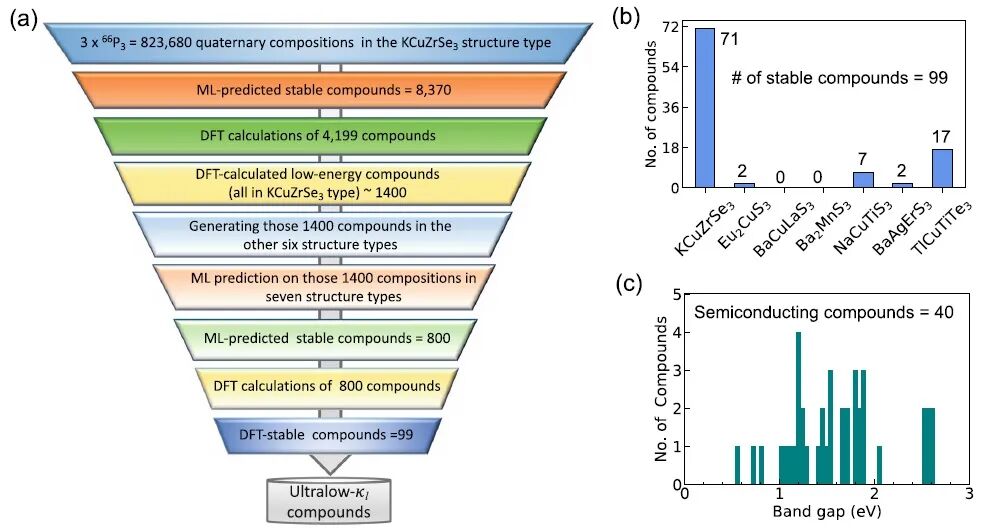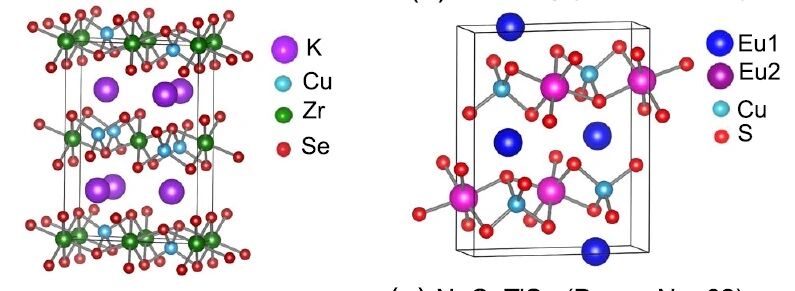研究材料的热传输性质,是在各种热能管理平台上寻找和部署合适材料的关键,如热障涂层、废热回收设备和需要快速散热的现代高性能计算架构等等。这个方向的一个持续的研究热点,是寻找具有极端热传输特性的材料。其中,具有极低晶格热导率 (κl) 的半导体材料很有希望能在热电学中得到应用,可将热能转化为电能。然而,如何发现以及合成新的化合物是材料科学中一项常重要但又极具挑战性的难题。传统上实验室都是采用试错法来合成新的化合物,但这种方法成本高、效率低。近年来,精确的量子力学方法、高通量密度泛函理论和机器学习等现代计算方法的发展,大大加速了新化合物的开发。
来自美国西北大学材料科学与工程系的Koushik Pal等人,设计了一种基于晶体图卷积神经网络的高级机器学习模型来发现新的四元硫属化物。这些化合物有超低的晶格热导率 (κl),有望在热障涂层和热电材料上有广泛应用。作者使用机器学习模型筛选了约 100 万种化合物的热力学稳定性,通过对一小部分化合物进行密度泛函理论计算后,发现了99 种稳定的化合物。他们使用 Peierls-Boltzmann输运方程计算化合物的κl,发现其超低的κl来源于柔弹性和强声子非谐性。该工作展示了尺度不变机器学习模型在预测新化合物方面的高效性,并为新材料在各种热能管理平台上的应用提供了理论指导。该文近期
发表于npj Computational Materials 8, 1-12 (2022),英文标题与摘要如下,点击左下角“阅读原文”可以自由获取论文PDF。
Scale-invariant machine-learning model accelerates the discovery of quaternary chalcogenides with ultralow lattice thermal conductivity Koushik Pal, Cheol Woo Park, Yi Xia, Jiahong Shen1 & Chris Wolverton
We design an advanced machine-learning (ML) model based on crystal graph convolutional neural network that is insensitive to volumes (i.e., scale) of the input crystal structures to discover novel quaternary chalcogenides, AMM′Q3 (A/M/M' = alkali, alkaline earth, post-transition metals, lanthanides, and Q = chalcogens). These compounds are shown to possess ultralow lattice thermal conductivity (κl), a desired requirement for thermal-barrier coatings and thermoelectrics. Upon screening the thermodynamic stability of ~1 million compounds using the ML model iteratively and performing density-functional theory (DFT) calculations for a small fraction of compounds, we discover 99 compounds that are validated to be stable in DFT. Taking several DFT-stable compounds, we calculate their κl using Peierls–Boltzmann transport equation, which reveals ultralow κl (<2 Wm−1K−1 at room temperature) due to their soft elasticity and strong phonon anharmonicity. Our work demonstrates the high efficiency of scale-invariant ML model in predicting novel compounds and presents experimental-research opportunities with these new compounds.
